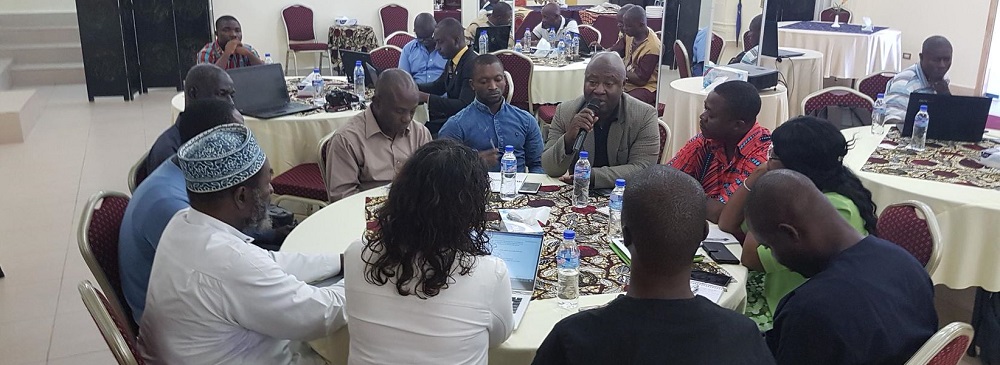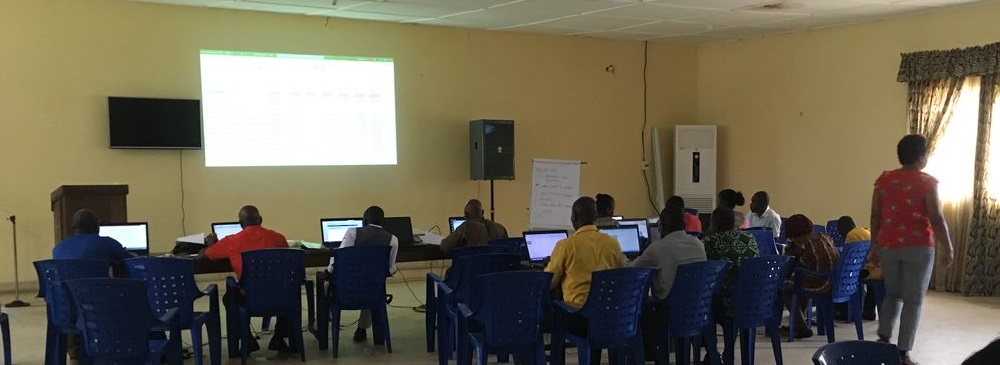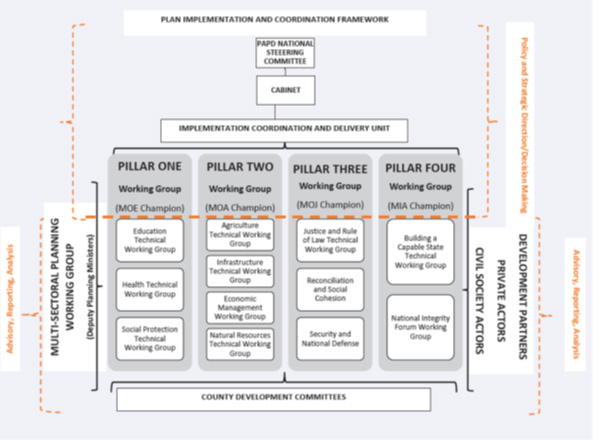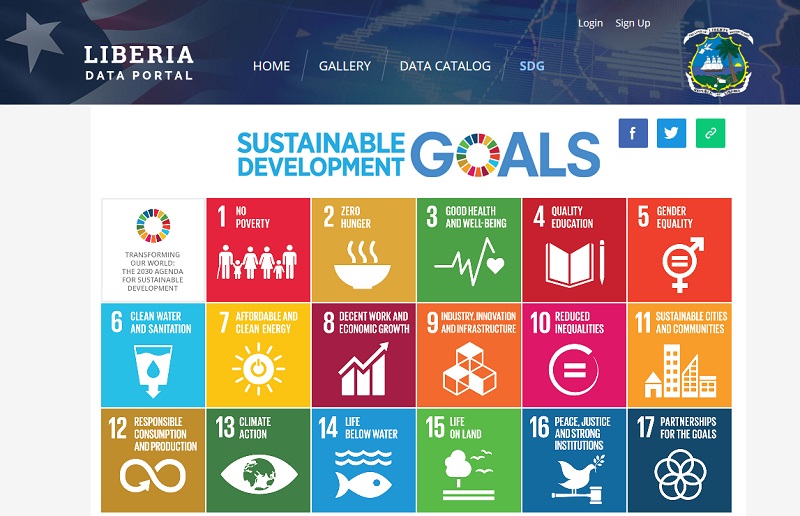Liberia
I. General on SDG monitoring set up
National SDG organizational set up
The Government of Liberia has decided to align Agenda 2030 with their national development plan, The Pro-Poor Agenda for Prosperity and Development (PPAPD) (LINK). The Ministry of Finance and Development Planning MFPD) is coordinating the ongoing work on this. Overall, it is the MFPD which is in charge of coordination linked to the SDGs. LISGIS has been given a coordination responsibility when it comes to the monitoring part of the work.
National set of SDG indicators
LMonitoring the SDGs and their indicators have been a challenge for Liberia. Properly monitoring change across the 169 targets, particularly on SDG Goal 16 given the strong reference to sustaining peace and building a capable state in the PAPD, will severely stretch the capacity of the national statistical system and those of government MACs. Accordingly, a minimalist approach has been formulated.
Identification and validation of the national key indicator involved both MFDP internal and external stakeholders for national development reporting on the PAPD. The process started after the launch of the PAPD in October 2018. The aim was to identify or select the NKIs and validate the selected NKI with MACs that are supposed to monitor and report on them. The MACs were then responsible to support the National Monitoring and Evaluation Unit by clearly defining the proposed NKIs, providing baselines were possible, and the reviewing of the PAPD targets. Moreover, the MACs helped in identifying the source for information on the NKIs, the responsible entity as well as the frequency for the monitoring of the indicators.
Currently, there are 140 high-level targets and 140 national key indicators of the PAPD. All the targets and indicators of the PAPD are linked directly to the targets and indicators of the global (Agenda 2030) and 26 continental (Agenda 2063) agendas. This indicates the government's willingness to support and promote the successful implementation of both agendas.
The mapping of SDG indicators to the PAPD key indicators is provided in the 2020 VNR, “ANNEX 1: Alignment between indicators of the current five-year national plan and the SDGs”
Source: https://sustainabledevelopment.un.org/content/documents/26288VNR_2020_Liberia_Report.pdf
SDG reports and Voluntary National Reviews
At the United Nations High-Level Political Forum on Sustainable Development held in July 2020, Liberia presented its first voluntary national review report (https://sustainabledevelopment.un.org/memberstates/liberia) including a national SDG indicator framework with baselines, targets and linkages to the national development agenda.
https://liberia.opendataforafrica.org/ujcozn
Liberia has chosen to use the Open Data Platform developed by the African Development Bank. The work is in progress. To date, the country’s National Statistical Strategy developed by the Liberia Institute for Statistics and Geo-Information Survey is serving as the fundamental guidelines for statistical analysis across the economic, social, environmental, and technological sectors at both national and sub-national levels. There exist an interactive National Projects System (allocation, disbursement, and results tracking) and expenditure monitoring system. Also, the SDGs monitoring platform that is currently undergoing development will be completely integrated with the National Data Warehouse.
The platform is to provide real time trend information on the SDGs indicators as well as provide budget performance information on projects/programs across the country. Furthermore, the platform will exclusively integrate with other platforms. That is, other systems like MOH Health Information Management System can easily be linked to the portal without manual human processing.
Source: https://sustainabledevelopment.un.org/content/documents/26288VNR_2020_Liberia_Report.pdf
Overall coordination of National Statistical System
LISGIS holds a core position in the monitoring of Liberia’s development plans, the collection and provision of official statistics, and the coordination of the NSS. LISGIS led the design and implementation of the first NSDS 2008-2013 (NSDS I). The NSDS I yielded substantive improvement in the production of relevant statistical and spatial information by LISGIS and the other NSS members despite remaining challenges. The second NSDS, 2018-2022 (NSDS II) analyzes the achievements of the NSDS I and the challenges, making recommendations and proposing priority actions. NSDS II has a strong focus on capacity development and the production of data related to supporting the development agenda of Liberia.
Liberia’s NSS is a decentralized system with multiple data producers, including ministries. These ministries conduct several statistical activities which are supported by international development partners, in most cases. Data is generally produced by the ministries according to their administrative needs. Thus, studies, including preparation of quality assurance frameworks applicable to data obtained from administrative sources should be realized to increase the use of administrative data in official statistics. To this end, the coordinating role of LISGIS in the NSS should be strengthened. An annual release calendar outlining all statistical indicators, responsible institutions of the NSS and expected publication dates can be another tool to improve coordination within the NSS.
The National Statistics and Geo-Information Act of 2004 (the Statistics Act 2004) was constituted as an initial action towards re-establishing the responsibilities for compiling and disseminating statistics by the Liberia National Statistical System (NSS). LISGIS was also created by this Statistics Act and given responsibility for compiling and collecting the data needed as well as establishing, developing and coordinating the NSS. The Statistics Act also defines the core functions of LISGIS, the governance structure of the NSS, objectives and data production requirements. It notes the need for coordination in data collection and compilation within the national statistical system, the need for strategic partnerships between producers and users of statistics, and the importance of a collaborative effort among all stakeholders. Additionally, the Act establishes the Statistics Board, comprised of various institutions of the NSS and given the responsibility to monitor and develop the NSS.
SDG data coordination committees
The National M&E Unit, the national coordinating body responsible to ensure the successful conduct of monitoring and evaluating at various pre-determined points of the life cycle of the PAPD at the national and sub-national levels. LISGIS, together with National M&E Unit, has the responsibility in coordinating the implementation of the National M&E Plan.
Responsibility for SDG indicator compilation
The Ministry of Finance and Development Planning developed data collection, monitoring, and reporting templates at the national level and distributed to various MACs through sector working group meetings. Progress on interventions was compiled by sectors and submitted to the Ministry of Finance and Development Planning. Mobile engagement teams were set-up to work with MACs that were slow in populating the templates. To verify reports coming from MACs, joint monitoring exercises were conducted with selected MACs, particularly MACs that implemented projects under the PSIP. The joint monitoring exercises were useful, as they helped verified information that MACs reported.
Going forward, a more systematic data collection quality monitoring system will provide the foundation for the PAPD National M&E framework by providing continuous information about implementation and results. The monitoring system will serve to detect irregularities and inefficiencies and allow the government and its development partners to correct them promptly.
Moreover, reliable information about the progress and quality of implementation will be presented on multiple platforms and at policy decision meetings.
Source: https://sustainabledevelopment.un.org/content/documents/26288VNR_2020_Liberia_Report.pdf
The government intends to establish dedicated coordination units, strategies and action plans, and accountability systems; beginning with a gap analysis or baseline study to assess existing policies elaborated under the PAPD concerning the global and regional commitments, and to identify areas where additional progress is needed. Properly monitoring change across 169 SDG targets will stretch even the most well-resourced NSS. Moreover, the 2030 Agenda notes the special situations faced by countries in conflict and post-conflict situations. Therefore, a minimalist approach focused on a fewer set of global and regional development goals could be the best option for alignment going forward. Defining and reaching an agreement on the elements of this approach will be a key goal of the baseline study.
Source: https://sustainabledevelopment.un.org/content/documents/26288VNR_2020_Liberia_Report.pdf
Actual data sharing mechanisms
The National Statistical and Spatial Data System in Liberia has improved since its start-up in 2008 but is constrained by a range of socio-economic statistics and spatial data issues. Significant data gaps exist despite the 2008 Population and Housing Census, the wide range of statistical surveys that have been conducted, significant administrative reports and records utilized, and the substantial number of statistical outputs produced. The integrated National Statistical and Spatial Database have not been fully utilized despite the call for full use of statistical systems under the Statistics Act of 2004. The formal National Spatial Data Infrastructure (NSDI) to support compatible spatial data across agencies is yet to be fully developed. In 2017, Liberia received a score of 60 out of a possible 100 on the World Bank Statistical Capacity based on selected international standards. This rating is nearly equivalent to the average of 60.5 for Sub-Saharan African countries. This new score showed a significant improvement from 46.7 out of 100 in 2014. Despite the improvement in WBSCI indicators, the NSS lacks human and physical capacity including information and communication technology (ICT), for regular data collection, compilation, standardization, analysis, storage, and dissemination. Primarily, limited dissemination of available statistics is particularly observed at LISGIS and the other statistics producing institutions of the NSS.
IV. Data availability and disaggregation
Work to make more indicators available
The current statistical capacity (CSC) of Liberia to compile global SDG indicators is assessed as being equal to 59 indicators (39 indicators are currently available and 20 are easily feasible). In relative terms, CSC is equal to 28% of the applicable global indicators (see Annex 1 for a tentative list of the global SDG indicators treated as not applicable in Liberia). It should be emphasized that out of 59 indicators, which are within the current statistical capacity of the Liberia NSS, 22 indicators (or 37%) are within LISGIS capacity , while 37 indicators (or 63%) are within the capacity of other NSS members (see Annex 2 for the list of the global SDG indicators which were assessed as being within the current statistical capacity of the Liberia NSS).
The monitoring of the SDGs and its targets face a data deficit despite a robust statistical system established by the government. The UN, bi-laterals, and international NGOs are seized of this challenge and need to do more to ensure reliable and timely data collection for select SDG indicators. Efforts are underway to strengthen statistical institutions technical capacities and infrastructure to have a place credible, sustain and relevant data and information-gathering systems at both national and sub-national levels as well as the skilled personnel to gather, analyze and report on the country’s national development plan and the targets of the 2030 Agenda.
Source: https://sustainabledevelopment.un.org/content/documents/26288VNR_2020_Liberia_Report.pdf
Work to allow more data disaggregation
Compilation of the indicators on sustainable development should be sustainable itself. However, the sustainability of assistance by the development partners should be assured with long-term commitments on many specific statistical activities. Additional assistance is urgently needed as the scope and the level of data disaggregation required for monitoring the country’s progress towards the 2030 Development Agenda is unprecedented and poses a serious challenge to the Liberia NSS. Continued assistance is needed also for setting up of an efficient national reporting platform to disseminate the compiled indicators (and related metadata) to national and international users.
A user engagement workshop was conducted in August 2019 with participants from LISGIS and line ministries. A user engagement strategy was developed, and key activities agreed upon, some of which have also been included in the plan of national activities.
Implementation plan and activities
The National Statistical System is committed to engage with users through the following mechanisms:
- Consultation mechanisms
- Focus groups: conduct focus groups with different users in order to incorporate their feedback at different stages to ensure efficient delivery of statistical products and services.
- One-on-one engagement: actively reach out to key users, e.g. policy makers, international agencies and NGOs, to get their input and views and to support their use of data and statistics.
- Townhall and palaver-hut meetings: conduct these meetings to engage the local communities, including traditional and religion leaders in our statistics produced, but also to hear from them what their needs and interests are.
- Fora and symposiums with specialized user groups: conduct high-level meetings with specialized user groups to jointly develop new products.
- Data literacy activities, such as various training courses, online and traditional, for media, students, community, traditional and religious leaders and other key users will be carried out regularly. This will be done to enhance users understanding of statistics, but also to learn more about their challenges and needs when it comes to statistics.
- Local champions such as county statistics information officers (CSIOs) and religious councils -we will engage with various champions for them to help us in engaging users in statistics.
- Outreach activities
- Use electronic and print media to reach different types of users in a timely and transparent manner and allow users to provide feedback through all of these means.
- The Website of LISGIS, including a data portal and statistical pages of websites of NSS members - use these to communicate statistics and other information to users in various formats
- Traditional and social media – we will use television, radio, newspapers, sms, social media and other tools to provide key messages in an easily understandable format to users, among others by using infographics and accessible language.
- Publications and promotional products – we will produce traditional and non-traditional products, including policy briefs, based on users input to increase visibility and interest among users.
- 3. Internal producer dialogue
- Interinstitutional meetings and technical working groups –meet regularly, coordinated by LISGIS, to discuss and exchange information on various topics.
- Trainings: will conduct trainings in statistics to increase accessibility and quality of the statistics and user-producer dialogues to enhance skills of statisticians in MACs of engaging with users
LISGIS have engaged data users through the following mediums:
- Website: www.lisgis.net
- Dissemination upon request – usually emails
- Newsletters – Monthly CPI Data
- RadioTalk shows
- Publications in hard copies through the Department of Information Dissemination and Coordination



